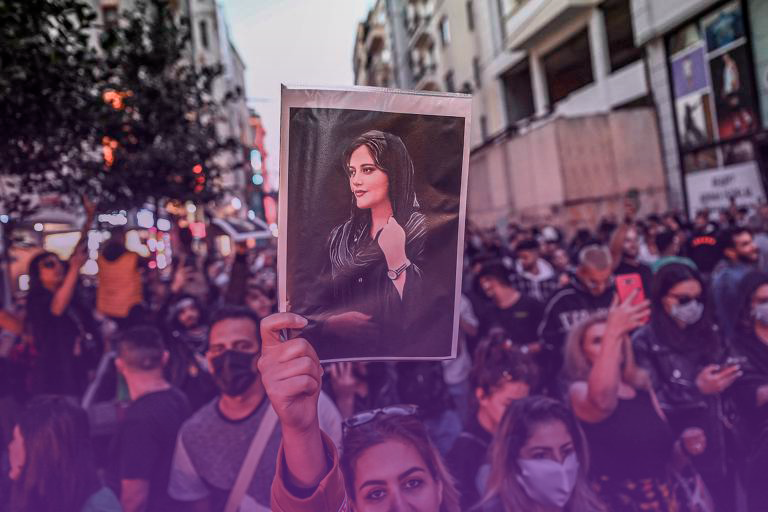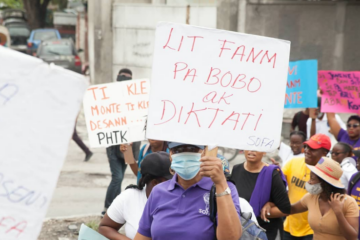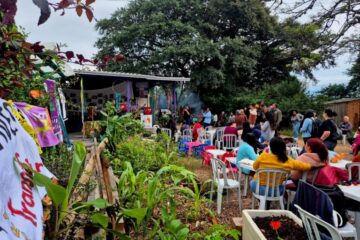The slogan “Women*, Life, Freedom” 1 in Farsi, an old known slogan in this region, has suddenly become a famous slogan world-wide, thanks to the on-going beautiful, impressive and brave movement taking place in Iran in the past weeks. But the long-standing isolation that the Iranian regime has forced on its people, and the renewed internet blackout, meant that we cannot know the extent and horror of the regime’s daily crimes, and also that we don’t know much about the Iranian society, women, and daily life.
Even as women from the same region, we have very few inputs on how women live in Iran, other than the fact that they live under an autocratic despotism, in which women’s presence and bodies are continuously policed, diminished and reduced.
In this interview with an Iranian feminist, we will try to see into the lives of women in Iran and their spaces of dissent in light of the on-going movement.
As an Iranian woman, what is allowed and not allowed for you to do, be, look like, say, etc, by the state, and by society? And how do these rules get applied, do women force each other to follow them or just the police?
Since the Revolution in 1979 in Iran, there has been a big line that separated the public sphere from private life. Especially for women, this line starts to show up in your life from the very first day that you go to school: you are not wearing a headscarf at home but you have to wear it in school. So this is your first encounter with the public sphere that is different from your home. This will grow up with you day after day when you become more and more involved in society; in university, in the workplace, in restaurants, in cinemas, etc.
Here the idea is not that as a woman I can not study, work or socialize with my friends. I can do all of these and in fact the number of women that have graduated from universities and entered the workplace has been prominently high in Iran in the past four decades. The idea is about “how” I have to be seen in society and how different it is from me. I believe this is the importance of compulsory hijab that would affect every aspect of your social life as a woman and it is irritating to see that it often gets downgraded to only a “headscarf” or a “dress code”.
What is the situation of women working in state institutions? Do you need to show your support to the regime for you to find a job in these institutions? Are there positions women cannot take in these institutions?
State institutions have very strict regulations for both men and women. Many of them often have many stages of entrance examination for any candidate and one of these examinations is about the ideological interviews with the candidates to assess their familiarity with religion and the system’s values and beliefs. The rules and regulations in many state institutions are a lot firmer than those in the private sector in terms of dress code or freedom of expression. Women in these institutions have more restrictions in terms of what they can wear. The headscarf that they wear in the streets is not allowed in these workplaces. Having makeup would create an issue for them and the list could go on.
I don’t know if there are positions that women could not take in these institutions but, again, the idea is not about the possibility of getting a job, it is mostly about the fact that, specifically as a woman, you are always asked to hide or forget a part of you that is not in line with the system’s ideology. Your body, your identity, your beliefs, your values have no place to be fully expressed.
Knowing that torturing and killing women is not an exception in Iran, why did the torture and killing of Mahsa Amini specificaly generate such a reaction? Did it coincide with specific conjectures, or was it more of an accumulation of events and attitudes and practices, and which are they?
It has been quite a rough time for people in Iran within the past couple of years. The economic situation has drastically deteriorated and millions of people are suffering from the excruciating inflation. The poverty line is increasing dramatically and the gap between the classes is unimaginable. The corruption of the ruling class beside the sanctions have affected the lives of millions of middle- and lower-class people. So I guess we were all waiting for a social explosion at some point due to this dire economic situation. Many social and political experts have been warning about it for years.
In such an atmosphere, the regime also keeps insisting on applying rules and policies to pressure women more and more and wipe them away from the public spaces. Within the past few months they passed several laws regarding women’s control on their bodies, women’s employment, the use of the hijab in public places etc. These have been on the news on a daily basis. So I believe society was already sensitized about the issues related to women. The shocking death of a 22-year-old woman under the custody of the police worked like pouring fuel on fire. This society that has been under tremendous economic pressure, with not a flame of hope for a better future on the one hand, and has to deal with different kinds of policies that limit their social life day by day. It just needed a very small trigger to explode and Mahsa (Jina)’s death was that trigger.
What are the main demands of the demonstrations till now? What are women demanding?
This uprising has been centered on women and their right to choose what to wear. Today we call it a feminist revolution because we are witnessing a nationwide mobilization around the issue of women and their control over their bodies. So acknowledging this right is the core of these demonstrations. But it is not limited to this.
The Islamic Republic claims that it functions based on Sharia and therefore any voice opposing the laws is considered as enmity with the religion. The demonstrators refuse to accept such claims and insist on a secular system in which all the citizens, regardless of their beliefs, are equally represented. They want a system that separates religion from the state, the judiciary system and the social rules and regulations. It obviously started with the issue of compulsory hijab but it does not end there. Compulsory hijab is the most explicit form of oppression on women but it’s not the only one. The personal status law that interferes with every aspect of women’s lives needs to be changed. Any policy that limits women from accessing their fundamental right needs to be abolished. That is why we see that the slogans in the streets shifted from compulsory hijab to changing the whole system immediately within a couple of days. Because the demonstrators truly believe that under this system, no fundamental change is possible.
How does the regime treat marginalized women*: poor, queer, peasant, uneducated, Christian, Jewish, Kurdish, etc?
Like in any other patriarchal, hierarchical, centralized system, discriminations exist in Iran based on personal, political, ethnical, social and economic status of people. The Shiite, religious, Fars, heterosexual, wealthy male would obtain more opportunities than anyone. Women under the personal status law are considered second-class citizens. Queer issues are completely absent in the Constitution. There are discriminations against ethnicities like Kurds, Arabs, Baluch communities in terms of learning their languages in school or having the right to be the president, for example. Other religions have to abide by the Shiite Islamic rules; for example, using the hijab in public places is also mandatory for non-Muslim women. So we can say oppression has different faces and discriminates people and communities differently based on their status.
How do the state and society treat expat Iranian women when they go back to Iran: does living “freely” abroad cost you something when you go back?
As long as the expats are not politically active in the diaspora, they would face no problem going back to Iran. But any form of political work in relation to Iran from other countries, sometimes it can be as small as giving an interview to a foreign media outlet about the situation in Iran, could cause a problem for them when they go back.
What is going on now in the streets: are the demonstrations only taking place in cities? Incities/regions that are generally known to be in opposition to the regime? In small towns/villages? Is it only taking the form of street demonstrations or also discussions, etc.? Who is in the streets, are there any political groups? Are they being formed?
The demonstrations have been going on for the past three weeks in many different cities. Some in mega cities like Tehran, the capital, and some in very small towns. Also universities and even schools have been protesting. It is a nationwide uprising even if not ALL cities take to the streets. The regime’s brutal crackdown doesn’t let any organized rally to be formed, therefore the protests are scattered from neighborhood to neighborhood. In some areas like Kurdistan, that was the start line of this uprising, there are more demonstrations, but it doesn’t mean that the rest of the country is silent.
There has been no political group leading or directing these demonstrations and no form of leadership has been formed. They are very spontaneous and this has its pros and cons. People out in the streets clearly refuse any form of leader due to the collective memory that Iranians have from the revolution in 1979. They don’t want any political group to hijack or take advantage of their uprising whatsoever. On the other hand, there is no organized political group to actually direct or organize any form of resistance. This is of course the situation right now and it might change in the coming days depending on how the demonstrations go on.
What are the profiles of the women mobilizing, organizing and joining the movement?
Although the presence of young women in the streets is very obvious, I don’t believe we can have a full picture of women demonstrations’ profiles only by watching the videos. The protests are happening in many different regions and many different women are taking part. There is still no statistics or study that can indicate the status of participants in this uprising.
How about feminist movement in Iran? Are there feminist groups or NGOs? Are they active? What kind of approach do they have and what is their role now during the demonstrations?
To answer this question, I think it is important to give a bit of context about the feminist movement in Iran. After the revolution in 1979 and the eight years of war afterwards, the social movements in Iran were completely damaged. Many leftists, intellectuals and former activists either got arrested or had to flee the country. So the feminist movement started to re-emerge around the mid-2000s, when the war was over and a reformist government took power and tried to open a tiny space for social movements to be formed.
Since 2000 to 2010, many forms of feminist collectives and organizations popped up that were working on different issues related to women’s rights. For example, the One Million Signature Campaign kicked off in 2006 as a grassroots movement to address the discriminatory personal status law against women. This campaign could organize many women in different cities and initiate the public discourse about women’s right in marriage, divorce, custody, etc. along with awareness campaigns about different forms of violence against women. This movement shed light on the Constitution and mainstreamed it within society. It wasn’t an easy job since the regime kept pressuring feminist activists, summoned them for interrogations, arrested them in the streets and in their houses. But the movement didn’t stop growing and getting new members despite all the difficulties.
The 2009 Green Movement in Iran and the brutal crackdown after that completely shut these grassroots. Many activists were arrested, many had to leave the country and the movement could not get back on its feet afterward. Within the past few years and with the help of social media, the feminists inside the country could continue their work mostly online, writing, making feminist discourse, organizing campaigns, etc. NGOs have never been allowed in Iran so the feminist movement has always been based on volunteers dedicating their time and effort without any financial support or fund.
This uprising did not happen in the vacuum. The roots of this uprising go back to all the efforts that the feminist activists have been doing all of these years. They tried very hard to keep society sensitive about the issues related to women and gender. They wrote, they taught and they organized under a very dire situation so that we can see today how society is aware of the discrimination against women and how it is responding to the oppression that women are facing on a daily basis.
Is there a coordination of women’s organizations? Also, what strategies do they have to organize those mobilizations, considering the restrictions on the internet and violent repression?
If there is any kind of women’s or feminist organizing groups in any shape, I would not know about them, because it would be very dangerous for them to announce it. So there might be a group of feminists inside the country to mobilize or maybe there isn’t. Outside the country on the other hand, a group of feminists in diaspora, who used to work together in the feminist movement back in 2006-2009, came together within the past couple of weeks and formed a network to coordinate events and rallies in different countries. Under the name of “Feminists for Jina,” they organized a feminist day of action in solidarity with women* in Iran on Sunday October 2. Feminists from 32 cities in the world joined the call and organized rallies, sit-ins, street art performances to show their solidarity. The network is currently working with other feminist groups, collectives and organizations around the world to raise the voice of Iranian women* and their demands from one hand and to initiate a feminist discourse that is inspired by the uprising in Iran.
We know that women participated very actively in the revolution in 1979, and had different expectations from the outcomes of their movement. What is the feminists’ reading of the “Islamic” revolution?
The Revolution in 1979 was not supposed to be an Islamic revolution. Different people with different beliefs participated in that revolution including leftists, seculars, Islamists and people who weren’t following any ideology. The Revolution was hijacked by the Islamists later on.
Women were the first group of people that opposed the recessive approach of the revolutionaries against women. They protested against Khomeini’s idea about the hijab on 8 of March 1979, only two months after the revolution.
They clearly refused to wear the hijab and made Khomeini take his word back. Later on, they continued their protest and got brutally oppressed. So at least a group of women (feminists) felt the danger of the religious control over their lives. But their voices were completely silenced by the propaganda of the revolutionaries and by the outbreak of war between Iran and Iraq. The new established system took the opportunity to suppress any opposition with the excuse of national security during wartime. Women and feminists never completely surrendered to the force of the hijab. They have been fighting it every day and in different ways.
How are the current mobilizations connected with the previous history of resistance and feminist struggles in Iran?
Like I said earlier, I don’t believe movements form in a vacuum. There is a history behind any step that a society decides to take. Fighting against the patriarchy in Iran goes back to more than a century ago, when women started fighting for their right to education, to publish their own newspapers, to get the right to vote, to fight for their civil rights. They have been fighting against dictatorships, religious leaders, political power, traditions and even families. Every movement needs to remember and cite the efforts that have been made before.
Feminist activists in Iran have come a long way to witness a day that everyone is shouting in the street “women*, life, freedom.” This does not happen suddenly and randomly. Especially within the past four decades, women showed tremendous courage fighting everyday against compulsory hijab, making it less and less similar to what the authorities approve. We came a long way to this day and I believe we have a long way ahead. And this is what this movement is about: to make our society acknowledge and respect equality and justice for women*.
How are these current mobilizations impacting communities? Are women receiving support and/or criticism (from whom?)?
So far it has been only support. I think society took a very big step forward. Two months ago no one could even imagine that an uprising would happen in Iran that pretty much centers on women*. It was not something that anybody would anticipate. Now we see women in the streets leading the demonstrations, putting up their slogans, fighting face to face with the police, burning their headscarves and everybody supports and follows them. This is not the society I knew two months ago. So I guess, at least at this point, it is very promising.
How do you want the women of the world to support you? Are there specific actions that the feminists around the world can do, other than what is being done now? Is there any way to build networks with feminists in the region and the world? And is this already happening and how, with whom?
I think feminist actions are very critical at this point. There is no question how heartwarming feminist solidarity would be for us now, but I think there is more to be done in terms of getting inspired by this uprising to build networks, especially in the region and in the global South, toward more connected movements and actions. I personally would like feminists to acknowledge that what we are facing in Iran is one form of patriarchal oppression, but it is not the only one. Women in many countries in the region are suffering under patriarchy in different ways.
The true solidarity movement would happen when we focus on our common struggle, open conversations with each other, make feminist discourse based on our lived experiences and raise a common voice against patriarchy in any shape and form.
- The asterisk was used to include all people who identify as such.[↩]




